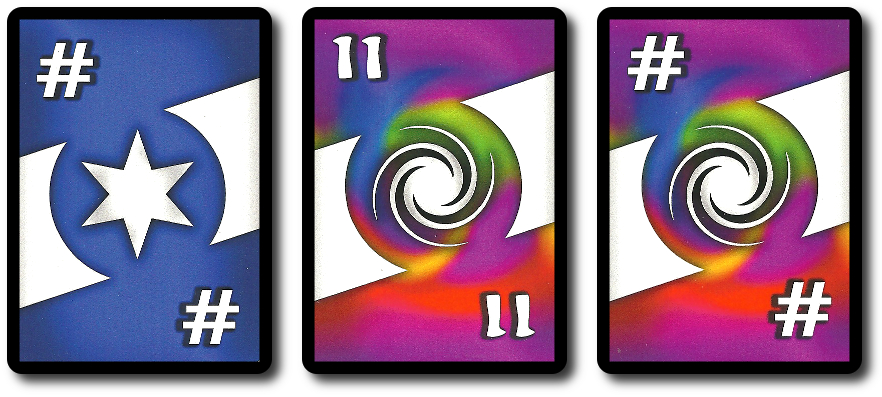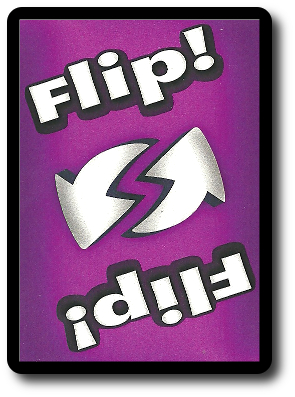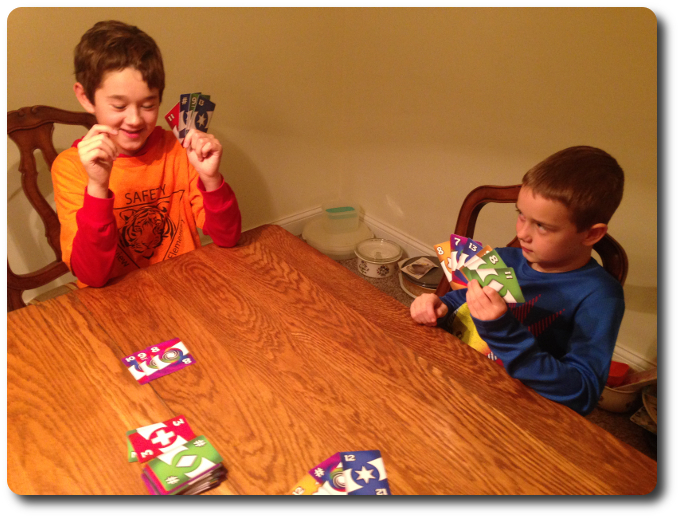
The Basics:
- For ages 8 and up (publisher suggests 12+)
- For 2 to 6 players
- Approximately 10 minutes to complete
Geek Skills:
- Counting & Math
- Logical & Critical Decision Making
- Memorization & Pattern/Color Matching
- Hand/Resource Management
Learning Curve:
- Child – Easy
- Adult – Easy
Theme & Narrative:
- None
Endorsements:
- Gamer Geek rejected!
- Parent Geek approved!
- Child Geek approved!
Overview
Life has a way of taking your plans and flipping them upside-down. One of the many reasons I wake up in the morning (other than that whole “being responsible’ thing) is my excitement for what the day might bring. Seldom am I disappointed. In this game, your plans all hinge on timing, but don’t be surprised if everything gets flipped around.
Flip!, designed by Ben Mora and published by Mora Games via the Game Crafter, is comprised of 89 cards. All the cards are as thick and as durable as your standard playing card. Not included with the game, and possibly necessary to play, is a pen or pencil and a piece of paper to keep track of players’ points.
Game Set Up
To set up the game, first shuffle the deck of cards and deal to each player 10 cards (if playing a 2 player game), 7 cards (if playing a 3 to 4 player game), or 6 cards (if playing a 5 to 6 player game). Players now pick up the cards so the side they see becomes the side they are viewing when they put them in their hand. The other side of the cards are only visible to the player’s opponents.
Second, place the remaining cards in the middle of the playing area. This is now the draw deck. Draw the top card, flip it over, and place it next to the draw deck to create the discard pile.
That’s it for game set up. Time to flip off some opponents.
Double-Sided Card Action
The cards in Flip! are double-sided, but the number values and colors are not duplicated. This means that each card is essentially 2 cards. The challenge (and for some, the problem) is that both sides of the cards are never visible. The player will have their hand and will be able to see one side of the cards and the backs of the cards that belong to their opponents. Using this, the player must determine when to take cards from other opponents, when to play their own, and when to mix the two together.

One card, two very different sides
And just to make the situation all the more tricky, the “Flip!” card takes everything the players’ know and turns it about, as we will soon see.
Just Flip It! Flip It Good!
Note: There are several ways to play Flip! The method described here is referred to as as the “Basic Game Play”. Additional methods of play are described in the “Game Variants” section.
Flip! is played in turns with no set number of turns per game. The first player to begin is the next player in turn order sequence left of the Dealer of the cards. A player’s turn is summarized here.
Step 1: Draw One Card
The first action the player takes on their turn is drawing 1 card from the draw pile. This is done by taking the top card and rotating it so only the active player can see the other side of the card that was not visible. This non-visible side is facing the active player when they place the card in their hand.
Step 2: Play Cards
The player now has several choices when it comes to playing cards. Only one of each of the following can be completed per player’s turn.
Play a Run
A run is a series of at least 3 cards that are organized in a repeating and non-breaking numerical sequence. For example, “1,2, and 3”. The card colors need to match, making the run a combination of same colored numerically sequenced cards that can range from 1 to 13. Players can use a combination of their own cards and their opponents’ if the value that is facing them in the opponent’s hand is usable.
Play a Set
A set is a series of at least 3 cards that share the same number value, but do not have to share the same color (colors include black, blue, green, red, and yellow). For example, a blue 12, a green 12, and a red 12. The color cannot be duplicated in the set, meaning each color can only contribute to a set once. Players can use a combination of their own cards and their opponents’ if the value that is facing them in the opponent’s hand is usable.
Laying Off
Players can also play off an opponent’s previously played Run and Set by adding to it. This is referred to as as “Laying Off”.
Cards can be added to a previously played Run if they add to either end of the numerical sequence, but they must be the same color. The minimum card value is 1 and the maximum card value is 13.
Cards can be added to a previously played Set if the number matches and the color the card provides has not already been played.
Again, players can use a combination of their own cards and their opponents’ if the value that is facing them in the opponent’s hand is usable.
Step 3: Discard
The last action the player takes is discarding 1 card from their hand to the discard pile.
Going Wild
There are two types of Wild cards in the game. The first is a Wild number value (indicated with the “#” symbol). This card can represent any number value between 1 and 13. The second is a Wild color value, which looks like a mix of colors, that can represent any color in the game. These Wild cards can be found for just colors, just numbers, or a combination of the two.

From left to right: Wild Number, Wild Color, and the highly coveted Wild Number & Color
When played to Runs and Sets, they must play by the rules of placing cards. That is, a Wild card cannot represent a number of color that is not possible or permissible within the Run or Set. For example, if a Set already has all the 5 colors, a Wild card cannot be added to it since all the colors have already been represented.
Flip the Table
As the last action, and completely optional, a player can place a card from their hand that is listed as “Flip”. This forces all players to take their hand and turn it around. The backside of the cards are now the side facing the player, which becomes their new hand.

Likewise, if an opponent takes a card from the player during their turn to create a Run or a Set that is a “Flip” card, the player can force the player to who stole the card to flip their hand before continuing their turn. This makes each player’s hand something of a landmine field that must be navigated carefully.
Winning the Game
The first player to play their last card (be it to the table or the discard pile) wins the game. If more than one game is desired (because one game only takes about 10 minutes to complete), play a “Best of 3” or a “Best of 5”. The player who wins the most games wins overall.
Game Variants
A number of game variants are available for those who want something a bit more than a Rummy like Card game. Each of the different games are summarized here.
Card Points
This game variant is very similar to the Basic game play, except that players count the number of cards left in their hand when a game is done. After a predetermined number of games have been played, the players calculate their total score. The player with the least amount of points wins the game.
Last Gamer Standing
This game variant reverses the Basic game play objective of getting rid of cards as quickly as possible. Now the players are attempting to be the last player with cards. The game rules suggest that players consider each card as part of the player’s “Life”. When they give up a card, they make themselves weaker. If they give up all their cards, they are out of the game.
Go Flippin’ Fishing
This game variant reduces the Basic game to nothing more than Go Fish, with the goal of the game to collect as many Books as possible. A “Book” is a set of 4 cards with the same number. The twist is that the players have access to the cards in their hand and the cards they see that belong to their opponent.
To learn more about Flip!, visit the game’s web page.
Final Word
The Child Geeks had no issue learning the game and quickly enjoying the passive aggressive game play. By far, the most enjoyable aspect of the game was stealing the cards from opponents, although this helped the opponent in the long run. No one really used the Flip card much, but they did go out of their way to hide it in hopes that an opponent would steal it from them. According to one Child Geek, “This game is all about grabbing what you can, as fast as you can.” Another Child Geek said, “This is one of the few games where I think you have the advantage if you go last.” So true! The more cards you have to work with, the better your odds of playing cards. But it was the speed in which the game was played, the intensity and pressure to always play “something” to the table that turned off the younger Child Geeks. According to one of the younger players, “I don’t like that people can steal my cards when all I want to do is just play them like everyone else.” And yet, it’s hard to say that the Child Geeks ever let the game’s goal get them down, since they kept coming back for more. In the end, the majority of Child Geeks voted to approve Flip!

My oldest son continues to have good cards, while his younger brother grows ever more resentful
The Parent Geeks found Flip! to be a good example of a casual card game that could be played by everyone without a lot of overhead or a measurable learning curve. According to one Parent Geek, “These are the kinds of games I like to bring to family gatherings or just have on hand. You can play it pretty much with anyone.” Another Parent Geek said, “This is a great game for the kids and the parents, as it isn’t too demanding, but all the players still have to think through their moves.” Which is to say, Flip! is not a game you can sleep through if you hope to win. The more competitive the player, the more intense the game becomes. The truly wonderful thing is, both casual and competitive groups can play the same game at the same time and have a fun experienced. All the Parent Geeks recognized this and voted to approve the game.
The Gamer Geeks recognized Flip! and a Rummy-style game with a slight twist of the flip and a few Wild cards thrown in. They were thoroughly unimpressed. According to one Gamer Geek, “I think the game is fine for casual players, but there is nothing here of interest for a serious gamer.” Where “serious gamer” means any player who is looking for a game of great depth, strategic game play, and tactical decisions. Flip! does make the player think, but is far from achieving the mental brain burn the Gamer Geeks look for. Another Gamer Geek said, “I like Rummy games and this one is fine, too, but it’s a game I would only play with my kids.” In the end, none of the Gamer Geeks thought that Flip! was a bad game, but nor did they think the game was for them.
Flip! has one thing going for it that always made me smile when I was playing it with our groups. It gives you the ability to shift everyone’s gears by flipping the player hands. Shift, not grind. Nothing in the game slows another player down, but you can cause a bit of a hiccup in an opponent’s plans. I liked this, as it allowed me to buy time for myself by flipping everyone’s hand around when I clearly had nothing to work with from my point of view. Of course, this tactic sometimes backfired, but with each game being 10 or less minutes long, even monumental mistakes become small lessons learned rather than game-changing errors.
My only complaint about the game is that it lacks a specific kind of information. I would have liked to have seen on each card a range of possible other card colors and values that “could be” on the other side of each card. Not a clear and obvious identifier, mind you, but a subtle hint of what might be lurking on the card’s other side. This would have helped me make better decisions when it came time to use the flip card. As it’s used today, it’s a forced randomizer without anyone knowing much other than they were better or worse off for it in hindsight.
Flip! is one of those games you can keep on a shelf and not play for months and then bring it down and everyone still remembers how to play. It’s very straight forward and has enough interesting game play to make it rememberable, which is a very good thing, since there are a ridiculous large number of Rummy-style and Rummy-variant games available. Flip! differentiates itself just enough to stand a few inches above the crowd, but its game play is commonplace, which makes it easy to grasp. It’s an interesting mix that works. Honestly, the hardest thing players will be confronted with is remembering not to look at certain sides of the cards when they draw them.
If you enjoy card games, especially those that are based around the rules of Rummy, then do play Flip! when the chance presents itself. It’s not a game that will make you flip your lid, but you will most certainly tip your hat.
This game was given to Father Geek as a review copy. Father Geek was not paid, bribed, wined, dined, or threatened in vain hopes of influencing this review. Such is the statuesque and legendary integrity of Father Geek.



